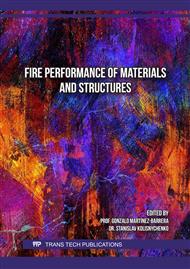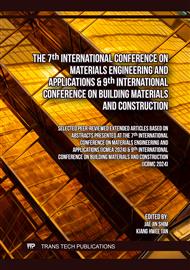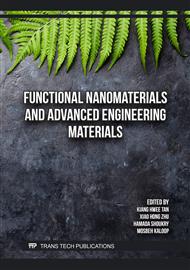[1]
Xie, T., & Tam, W. Y, "Study on the use of recycled concrete: a comparison of properties", Civil Engineering Magazine, Vol 20(3), pp.112-125, (2022)
Google Scholar
[2]
Zhang, J, "Experimental study on recycled concrete and its mechanical behavior", Construction Materials Magazine, Vol 58(3), pp.123-136, (2006)
Google Scholar
[3]
Vieira J.P.B., G. Correia, J.R., & de Brito, J, "Post-fire residual mechanical properties of concrete made with recycled concrete coarse aggregates", Cement and Concrete Research. 41(5), (2011)
DOI: 10.1016/j.cemconres.2011.02.002
Google Scholar
[4]
Varona, F. B., Baeza-Brotons, F., Tenza-Abril, A. J., Baeza, F. J., & Bañón, L. (2020). Residual compressive strength of recycled aggregate concrete after exposure to high temperatures. Materials 2020, Vol. 13, Página 1981, 13(8), 1981
DOI: 10.3390/MA13081981
Google Scholar
[5]
Jimenez L., Moreno E., Rosado-Gruintal A. (2014). Limits of use of recycled coarse aggregate of limestone origin in structural concrete based on mechanical and elastic properties. VI National Congress ALCONPAT 2014.
Google Scholar
[6]
Salahuddin, H., Nawaz, A., Maqsoom, A., Mehmood, T., & Zeeshan, B. (2019, 3). Effects of elevated temperature on performance of recycled coarse aggregate concrete. 202, pp.415-425.
DOI: 10.1016/j.conbuildmat.2019.01.011
Google Scholar
[7]
Gales, J., Parker, T., Cree, D., & Green, M. (2016). Fire Performance of Sustainable Recycled Concrete Aggregates: Mechanical Properties at Elevated Temperatures and Current Research Needs. 52(3), págs. 817-845.
DOI: 10.1007/s10694-015-0504-z
Google Scholar
[8]
Ahmed, W., Lim, C. W., & Akbar, A. (2022). Influence of Elevated Temperatures on the Mechanical Performance of Sustainable-Fiber-Reinforced Recycled Aggregate Concrete: A Review. Buildings, 12(4)
DOI: 10.3390/BUILDINGS12040487
Google Scholar
[9]
Akhtar, M., Halahla, A., Almasri, A., & Author, C. (n.d.). Experimental Study on Compressive Strength of Recycled Aggregate Concrete under High Temperature. https://doi.org/10.32604/ sdhm.2021.015988
DOI: 10.32604/sdhm.2021.015988
Google Scholar
[10]
Cree, D., Green, M., & Noumowé, A. (2013). Residual strength of concrete containing recycled materials after exposure to fire: A review. 45, pp.208-223.
DOI: 10.1016/j.conbuildmat.2013.04.005
Google Scholar
[11]
Hager, I., Mróz, K., Tracz, T., Kocí, V., & Fiala, L. (3 de 2022). Equivalent Thermal Diffusivity of Natural and Recycled Aggregate Concrete At Temperature Up To 350 °C. 33, págs. 207-211.
DOI: 10.14311/app.2022.33.0207
Google Scholar
[12]
Fernandes, B., Carré, H., Mindeguia, J., Perlot, C., & La Borderie, C. (3 de 2022). Fire Spalling Sensitivity of Concrete Made with Recycled Concrete Aggregates (RCA). 33, págs. 168-174.
DOI: 10.14311/app.2022.33.0168
Google Scholar
[13]
Yang, H., Lv, L., Deng, Z., & Lan, W. (2017, 6). Residual compressive stress-strain relation of recycled aggregate concrete after exposure to high temperatures. 18(3), pp.479-486.
DOI: 10.1002/suco.201500153
Google Scholar
[14]
Pliya, P., Cree, D., Hajiloo, H., Beaucour, A., Green, M., & Noumowé, A. (9 de 2019). High Strength Concrete Containing Recycled Coarse Aggregate Subjected to Elevated Temperatures. 55 (5), págs. 1477-1494.
DOI: 10.1007/s10694-019-00820-0
Google Scholar
[15]
González-Fonteboa, B., Seara-Paz, S., de Brito, J., González-Taboada, I., Martínez-Abella, F., & VaSCO-Silva, R. (n.d.). Recycled concrete with coarse recycled aggregate. An overview and analysis; Hormigón reciclado con árido grueso reciclado. Una visión general y análisis. 68, 151
DOI: 10.3989/mc.2018.13317
Google Scholar
[16]
Yang, S. (n.d.). Effect of Different Types of Recycled Concrete Aggregates on Equivalent Concrete Strength and Drying Shrinkage Properties
DOI: 10.3390/app8112190
Google Scholar
[17]
Gales, J., Parker, T., Cree, D., & Green, M. (2015). Fire Performance of Sustainable Recycled Concrete Aggregates: Mechanical Properties at Elevated Temperatures and Current Research Needs. Fire Technology 2015 52:3, 52(3), 817–845
DOI: 10.1007/S10694-015-0504-Z
Google Scholar
[18]
Laneyrie, C., Beaucour, A., Green, M., Hebert, R., Ledesert, B., & Noumowe, A. (5 de 2016). Influence of recycled coarse aggregates on normal and high-performance concrete subjected to elevated temperatures. 111, págs. 368-378.
DOI: 10.1016/j.conbuildmat.2016.02.056
Google Scholar
[19]
Varona, F. B., Baeza-Brotons, F., Tenza-Abril, A. J., Baeza, F. J., & Bañón, L. (2020). Residual Compressive Strength of Recycled Aggregate Concretes after High Temperature Exposure. Materials 2020, Vol. 13, Page 1981, 13(8), 1981
DOI: 10.3390/MA13081981
Google Scholar
[20]
Maciá, M. E., Castillo, Ángel, Martinez, I., Francisco, ·, & Rubiano, J. (n.d.). High-Temperature Residual Compressive Strength in Concretes Bearing Construction and Demolition Waste (CDW): An Experimental Study. Transactions of Civil Engineering. https://doi.org/10.1007/ s40996-022-00895-w
DOI: 10.1007/s40996-022-00895-w
Google Scholar




